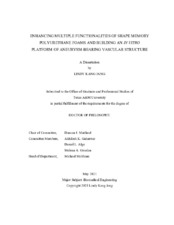| dc.description.abstract | Shape memory polyurethane (SMP) foams have multiple adequate features to be utilized as a hemostatic device or an embolic device such as their unique shape recovery property, excellent biocompatibility, and rapid hemostatic property. SMP foams can be delivered to a targeted site with minimal invasiveness to treat severe hemorrhage or aneurysms. However, SMP foams have a few limitations such as slow degradation rate to match a wound healing timeline, insufficient fluid absorption, and the lack of X-ray visibility. It is also challenging to properly evaluate endovascular embolization device performance and train medical personnel for device deployment with current in vitro aneurysm models. In this dissertation, unique ways to improve the biodegradability, fluid absorption capacity, and X-ray visibility of SMP foams are illustrated. Also, the development of a living in vitro aneurysm platform using three-dimensional hydrogel printing technology is described. The biodegradability of the SMP foams was accelerated by adding ester-containing monomers in the foams which increased the degradation rate both oxidatively and hydrolytically while the thermal properties remained to be suitable for hemostatic use. Fluid uptake capacity was enhanced by synthesizing a SMP foam-hydrogel composite that maintains unique mechanical properties from SMP foam and high fluid absorption capacity from hydrogel. The composite could also expand quicker, and clot blood more rapidly compared to the foam. The radiopacity was introduced to SMP foams by adding both physical and chemical X-ray contrast agents into the foam structure. This enabled visualization of neurovascular scale foam via X-ray spectroscopy. An in vitro platform of aneurysm-bearing vascular structure was built using gelatin-fibrin hydrogel of which the inner vessel walls were seeded with human cerebral microvascular endothelial cells (hCMECs). An embolization coil was deployed to the printed aneurysm sac using a catheter and the blood plasma clotting around the coils was monitored. The SMP foams with enhanced biodegradability, fluid uptake capacity, or radiopacity possess great potential as an effective hemostatic or embolization device for treatment of hemorrhage or aneurysms. Furthermore, the biomimetic in vitro aneurysm platform is a promising method for examining the biocompatibility and hemostatic efficiency of embolization devices. | en |


